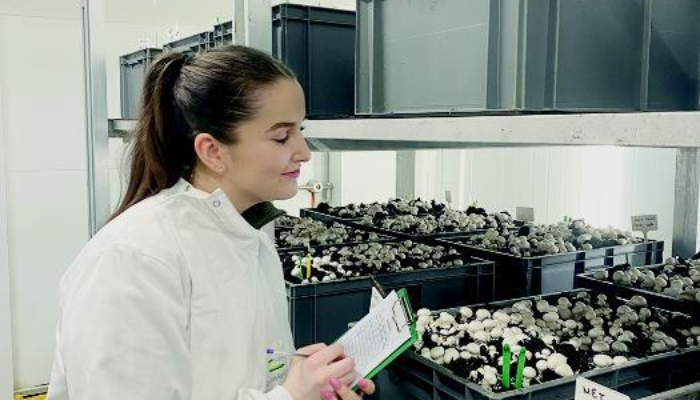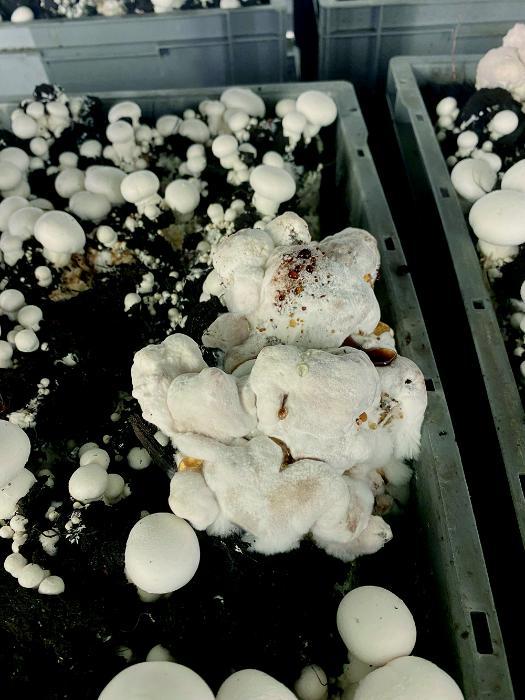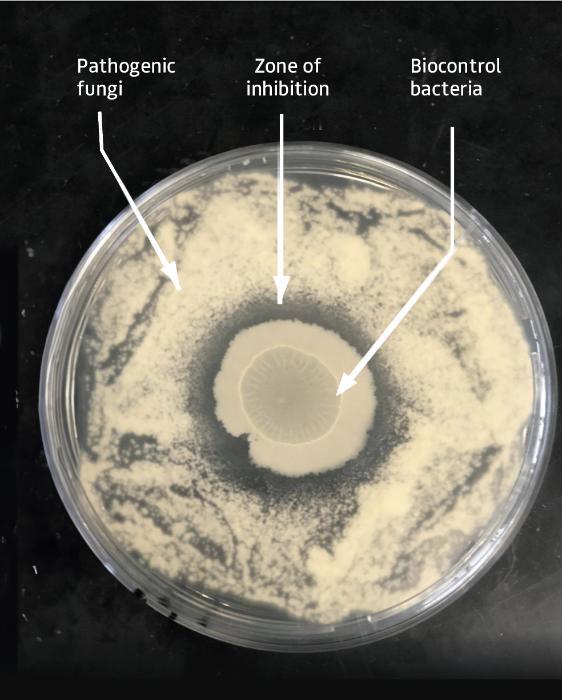08 February 2025
Bubble trouble? Mushroom Disease Control

Joy Clarke, Teagasc Walsh Scholar, reports on the key results from her work on understanding how biocontrol and integrated pest management (IPM) approaches can support the mushroom sector in controlling disease outbreaks.
The mushroom industry is the largest horticulture sector in Ireland. Currently, there are 40 mushroom production units located across the country, producing a massive 68,000 tonnes of mushrooms annually. Growers are constantly monitoring their crops for the appearance of disease that could severely affect their yield and overall profits.
Several diseases may impact a mushroom crop; a research project at Teagasc Ashtown’s Horticulture Development department focused on two important fungal mushroom diseases: dry bubble disease (caused by Lecanicillium fungicola) and cobweb disease (caused by Cladobotryum spp.).
Shroom for an alternative?
Traditionally, growers have relied on good hygiene and chemical fungicides to control disease. However, the number of approved fungicide products available has reduced considerably over the past 20 years and, with so few chemicals available, there is now a significant risk that fungicide resistance will emerge. The overall goal of this project was to investigate alternative disease treatment methods with a focus on biocontrol and integrated pest management (IPM) strategies, explains Joy Clarke, a Teagasc Walsh Scholar.
“Biocontrol involves the application of microorganisms to a crop that can prevent or reduce the growth of pathogens or pests. Often, these microorganisms have lived alongside the pathogens within the same environment and have naturally evolved ways to compete with them. When we increase the population of the biocontrol species, we hopefully anticipate that they will reduce the growth of the pathogens and thus reduce disease incidence.”
In 2019, several bacterial strains were isolated from mushroom casing material and were tested for their abilities to reduce the growth of Trichoderma, a fungus that causes green mould disease on mushrooms. One bacterial strain that showed the best potential was selected to be the novel biocontrol strain included in this work. It was identified as a Bacillus velezensis species and was designated as B. velezensis Kos. The research team also chose to include a second biocontrol strain, B. velezensis QST 713, which is commercially available in the biocontrol product Serenade®.
Stress-testing
The project began with an investigation of the abilities of these biocontrol strains to reduce the growth of the pathogens which cause both dry bubble and cobweb disease in vitro or in the lab. This involved various inhibition assays and experiments, determining that growing the pathogens with the biocontrol bacteria caused significant growth reductions and physical damage to the pathogens, Joy explains.
“We used proteomic techniques to learn more about this interaction. By investigating the different proteins which are expressed in response to treatment, you can essentially determine how the pathogen responds to the biocontrol bacteria. We found that stress-related proteins were increased when the fungal pathogens were exposed to the bacteria, and growth proteins were reduced.”
Overall, the team saw extremely positive results from their lab work for both pathogens with both biocontrol strains. However, within a mushroom crop environment there will be several hundred additional microorganisms that may affect this interaction. The next task was to test the biocontrol strains in crop trials, to obtain more realistic results of how these treatments might work for the growers.

Dry bubble disease on a mushroom crop. Photo credit: Teagasc.
Trialling the treatments
The team carried out five large-scale disease trials in the industry-standard growing rooms at Ashtown’s Mushroom Research Centre. The researchers infected crops with a pathogen – for either dry bubble or cobweb disease – and applied the biocontrol treatments to see if they could control disease symptoms.
“We also included traditional fungicide treatments, such as prochloraz and metrafenone, to compare the biocontrol treatments to conventional treatment methods,” Joys adds.
“Prochloraz performed very well during crop trials, inhibiting disease symptoms of both pathogens significantly and preventing significant yield reductions. However, soon after this work was completed, the approval for use of prochloraz on mushroom crops in the EU was revoked. At the same time, we identified pathogen isolates that were resistant to the remaining fungicide, metrafenone. These results emphasised the importance of finding alternative disease control strategies for the sector.”
Joy continues: “Although we generated some positive results for the biocontrol treatments, we determined that the level of disease inhibition achieved was less significant than what we had seen in our laboratory work.”
Chemical fungicides performed much better under high disease pressure, but the biocontrol treatments showed potential under low to moderate disease pressure. The researchers analysed samples of the biocontrol-treated mushroom casing over the course of a crop and found that adding these bacterial strains did not alter the natural casing microbiome population and that the biocontrol bacteria were not persisting after application.
“This could explain the differences between our lab and crop-based studies,” adds Joy.
“Perhaps we need to look for biocontrol bacteria that are better able to compete with other microorganisms within the mushroom environment in order to improve efficacy in the field.”

Pathogen inhibition with a biocontrol bacterium. Photo credit: Teagasc.
Encouraging results
During this work, the researchers found that disease proliferation was significantly reduced on plots that were monitored carefully, and where any early patches of disease were treated with salt to kill off the pathogen. This is a key principle of IPM; these results are extremely important, as they prove that disease-monitoring and early treatment is a worthwhile IPM strategy for growers to apply on their farms, Joy explains.
“If we can encourage growers to combine this important IPM principle with the application of biocontrol treatments, it should be possible to reduce disease levels on mushroom crops, without having to rely heavily on fungicide products.
“Overall, the findings of this research have made significant contributions to a workable IPM strategy for the mushroom sector.
“We have shared these results with the industry through multiple presentations at global grower events – Dutch Mushroom Days 2023, 19th & 20th ISMS Congresses, 26th NAMC conference – as well as at scientific conferences,” Joy concludes.
This article was first published in TResearch Winter 2024
This project was funded by the Teagasc Walsh Scholarship programme.
Contributors
- Joy Clarke, Teagasc Walsh Scholar, Horticulture Development Department, Teagasc, Ashtown.
- Helen Grogan, Senior Research Officer, Horticulture Development Department, Teagasc Ashtown. helen.grogan@teagasc.ie
- David Fitzpatrick, Associate Professor, Department of Biology, Maynooth University.
- Kevin Kavanagh, Professor Department of Biology, Maynooth University.
